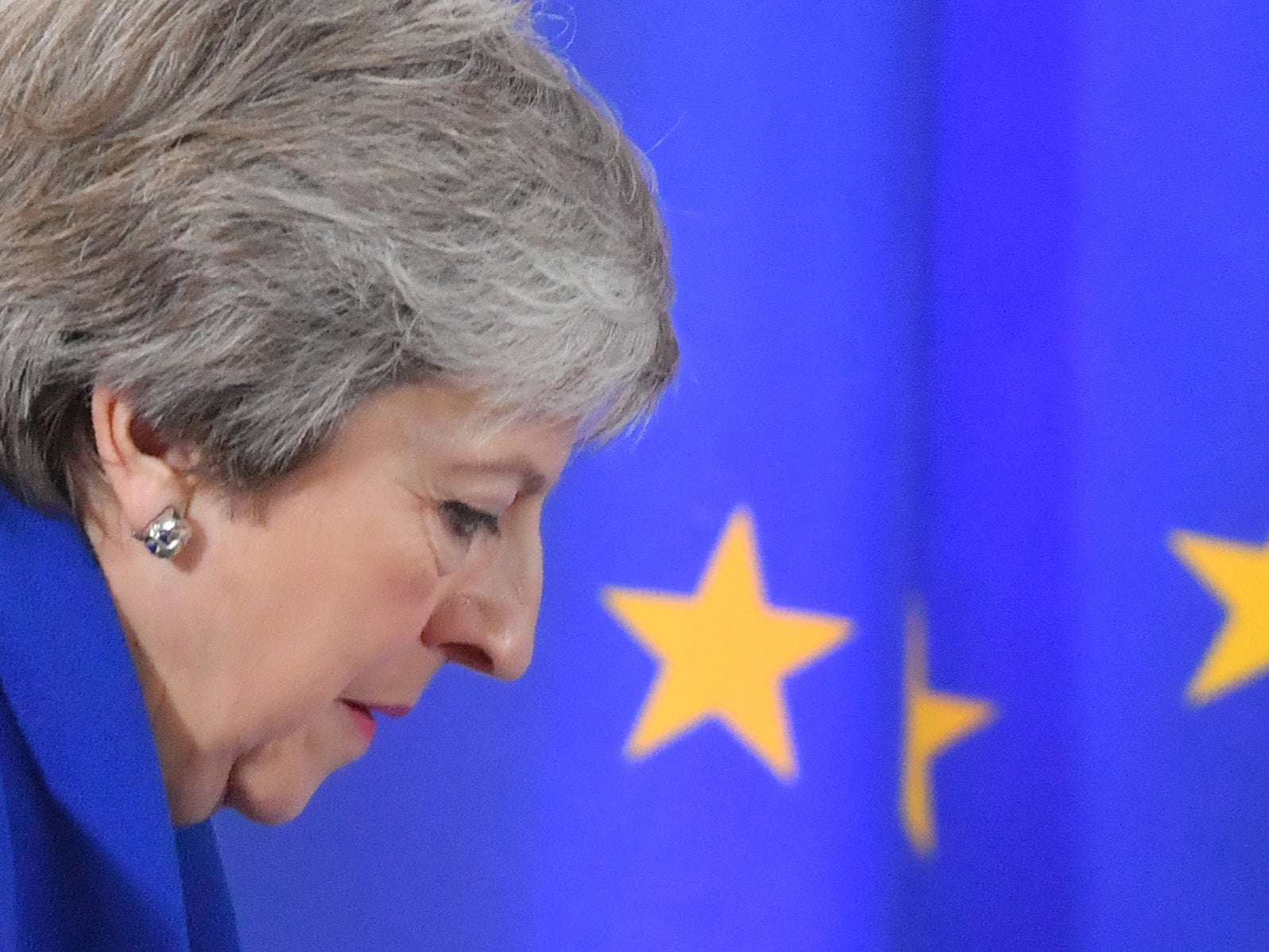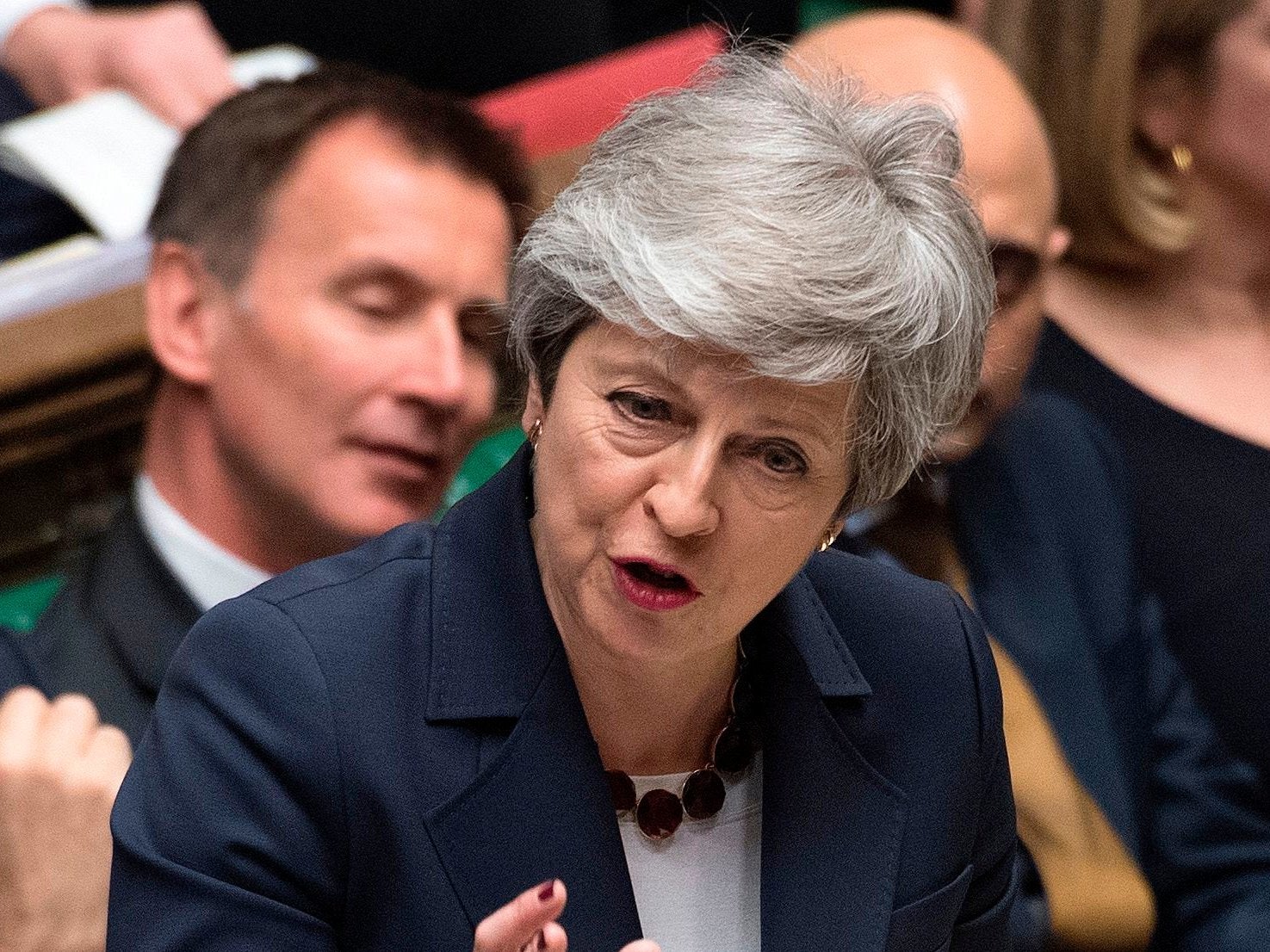Theresa May: The fall and fall of the ‘Brexit prime minister’ who couldn’t even deliver Brexit
May put the unity of the Tory party before that of the country, and it has ended up costing her dearly, says Andrew Grice


In adversity, Theresa May produced one of her best performances at prime minister’s questions on Wednesday.
It reminded old Westminster hands like me of Margaret Thatcher’s remarkable display at the despatch box after she had announced her resignation in 1990.
The parallel was apt. Four hours after PMQs, May promised Conservative MPs she would stand down if the Commons approved her Brexit deal.
It was enough to persuade several Eurosceptics to back her agreement. For a few hours, there was real hope in Downing Street that a majority was finally in sight.
Then normal service resumed. The Democratic Unionist Party restated its opposition, halting the Tory momentum towards backing the deal. May’s gamble had failed. A joke did the rounds in parliament: May was so useless, she couldn’t even resign properly. No Margaret Thatcher, certainly.
The episode epitomises May’s premiership. It has been punctuated by mistakes. She did not want to be “the Brexit prime minister”, and longed to pursue a domestic agenda. She judged, rightly, that the 2016 referendum result was not really a vote against the EU, but a cry from the “left-behind”.
Her speech in Downing Street on becoming prime minister, pledging to help the “just about managing” and to root out “burning injustice”, was pitch perfect. But she never lived it up to it. True, there were initiatives – some welcome, such as a race disparity audit. But any prospect of a coherent, meaty agenda was eclipsed long ago by Brexit, which, in Whitehall speak, left little “bandwidth” in the government machine for much else.
May never really recovered from her early Brexit errors. As a reluctant Remainer, she was desperate to reassure Brexiteers she would deliver on the referendum result. The pivotal moment was the Tory conference in October 2016.
In a speech drafted by her close aide Nick Timothy – which, crucially, bypassed the Whitehall machine – May set the red lines which would dominate the Brexit negotiations. The UK would leave the customs union, end the free movement of people (which would mean leaving single market) and end the jurisdiction of the European Court of Justice. Senior civil servants were appalled; some believed May did not understand how she was closing off her options.
One of the bitter ironies of the Brexit saga is that only now, with parliament trying to seize the reins, is there a proper and long overdue debate about the merits of the customs union and the single market.
The one thing I underestimated when I went into No 10 was the extent to which the prime minister is steeped in the DNA of the Conservative Party
In her conference speech May, under intense pressure from Tory Eurosceptics to get a move on, promised to trigger the two-year Article 50 exit process by March 2017. Some allies now concede this was premature, as she did not have a clear vision of what she wanted.
Her rigid red lines might have worked if she had sought a limited, Canada-style free trade agreement, which the EU would have accepted. But, with Whitehall and business warning about the economic cost of ending frictionless trade and a slender majority of 12 in a Commons with Remainers in the ascendancy, May would struggle to secure UK approval for such a deal. The answer, May was told by cabinet ministers Philip Hammond and David Davis, was to call a general election and secure a big majority.
Although she had originally ruled one out, she was persuaded to U-turn, with opinion polls raising her allies’ hopes she could win a majority of 80. It was her second fatal mistake. She wanted a “Brexit election” but Jeremy Corbyn had other ideas, exposing May’s Achilles heel on domestic policy by focusing on austerity.
May’s loss of her overall majority meant that today’s power struggle between the government and the Commons was only a matter of time. Yet she remained in denial about the parliamentary arithmetic. She could have changed course towards the soft Brexit majority among MPs, but rejected overtures for her to reach across the aisle, and reach out to the 48 per cent she had neglected since the referendum.

Crucially, May put the unity of the Tory party before that of the country. As Chris Wilkins, her former director of strategy, recalled this week: “The one thing I underestimated when I went into No 10 was the extent to which the prime minister is steeped in the DNA of the Conservative Party. It was a central tenet when I was there that she would be the prime minister of the country, not the leader of the Conservative Party, but [actually] the fact that she ... prioritised the unity of that party has led to lots of the inflexibility.”
Despite warning of the hard choices ahead, May consistently put them off in an attempt to ensure her own survival and preserve Tory unity.
She defied her critics by getting the EU negotiations over the line at crucial stages, but without resolving the fundamental contradiction in her strategy. She pledged to avoid a hard border on the island of Ireland and, under pressure from the Democratic Unionist Party on whose Commons votes she depended, promised to avoid a different regulatory and tariff regime in Northern Ireland and Great Britain. But she also insisted the UK must be able to strike trade deals with non-EU countries. She has still not solved this puzzle and the DUP remains opposed to her withdrawal agreement.
May tried to square the circle when she finally produced her Chequers blueprint. But she failed to win the frictionless trade she sought in the fraught negotiations with the EU.
She and her ministers made a series of miscalculations. They approached the talks as if they were a traditional EU negotiation among 28 partners, not realising that it would be 27 versus one. They were convinced the UK could “divide and rule” but the EU maintained iron discipline and unity. May tried to woo her fellow leaders, but they deliberately left the European Commission in the driving seat. (It was revealing that the first cracks finally showed this month when the 27 leaders rather than the European Commission decided on an Article 50 extension.)
The EU thus called the shots and fixed the timetable. May’s naive hopes that a long-term trade agreement would be sorted by exit day today were dashed. The EU insisted on first resolving the UK’s divorce payment, citizens’ rights and a backstop to prevent a hard Irish border – with no talks on the future relationship until after the UK’s departure.
Even when May’s diplomacy worked – she secured a UK-wide customs union instead of a Northern Ireland-only one – it antagonised the noisy Eurosceptics. The withdrawal agreement which emerged left them seething at “Brexit in name only”, while pro-Europeans saw it as much worse than EU membership, fuelling demands for a Final Say referendum.
In another catastrophic error, May made a televised address in which she blamed the deadlock on parliament, insulting the very MPs – particularly on the Labour side – whose votes she so desperately needed
May’s prioritising of Tory unity failed to prevent 28 ministerial resignations (18 of them over Brexit) in less than three years, more than Thatcher suffered in 11. The departures did not ensure cabinet unity – far from it. Discipline has broken down. May has been pushed one way and then another by resignation threats from Brexiteer and pro-EU ministers.
Her once-admired resilience is now seen as stubbornness by frustrated ministers, who long for her to give a lead at a time of national crisis. They leave cabinet meetings on Brexit with no idea of what will happen next because the inscrutable May keeps her cards nailed to her chest.
After two crushing Commons defeats for her agreement in January and March, May had the humiliation of pleading with the EU to extend the UK’s membership beyond today’s original exit date. By now she knew her legacy would not only be as the “Brexit prime minister” but possibly as the one who failed even to deliver Brexit.
The pressure was inevitably taking its toll. In another catastrophic error, May made a televised address to the nation in which she blamed the deadlock on parliament, insulting and offending the very MPs – particularly on the Labour side – whose votes she so desperately needed. In that moment, the die was probably cast.

May thought she had one last roll, even though it meant giving up hope of forging a post-Brexit domestic agenda. In an attempt to hold her factious party together, she sacrificed her other central objective – her own survival – by promising to quit if her MPs gave her a majority for her deal.
But with her focus on the Tories, she made yet another miscalculation: Labour MPs representing Leave areas, already furious at her attack on parliament for doing its job, now feared her departure would see a hardline Brexiteer succeed her, making them even less likely to carry her deal over the line. Despite May’s efforts to woo them, only five Labour MPs backed her in today’s Commons vote.
After a third defeat for her withdrawal agreement – albeit by a less margin – the game may be up.
Join our commenting forum
Join thought-provoking conversations, follow other Independent readers and see their replies
Comments